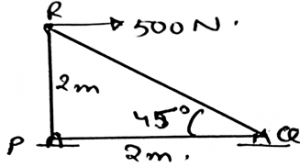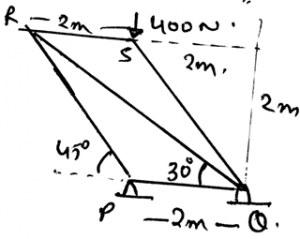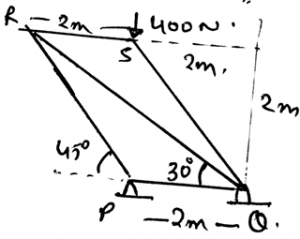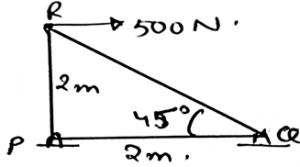This set of Engineering Mechanics MCQs focuses on “Simple Trusses – 2”.
1. The joint in the trusses are generally formed by welding the materials at the ends of the trusses on a common plate. Which gives strength to the design. What is that plate called?
a) Gusset Plate
b) Ignified plate
c) Non-metallic plate
d) Gymnite plate
View Answer
Explanation: The joint in the trusses are generally formed by welding the materials at the ends of the trusses on a common plate. Which gives strength to the design. This plate is known as Gusset plate. This plate holds up various trusses that are being welded to it , to make the structure strong.
2. Find the force in the member RQ of the frame shown below.

a) 707.1N
b) 500N
c) 505N
d) 784N
View Answer
Explanation: The direction of the unknown is not known to us. To know the direction of the unknown force we take assumption of it. That is we assume that the particular direction might be the direction of the force and then we do the calculations accordingly. And then we apply the equilibrium equations to the joints.
3. Trusses lie in a single plane. And the calculations used to solve the forces are from vector math.
a) The first part of the statement is false and other part is true
b) The first part of the statement is false and other part is false too
c) The first part of the statement is true and other part is false
d) The first part of the statement is true and other part is true too
View Answer
Explanation: The loading is acting in a plane. Thus the calculations are done in 2D only. As the equations for 3D are different. Although the use of vectors can make our task easy but still 2D calculations are done for the trusses, as they are acting in a same plane.
4. The transmission of the load on a certain type of a structure follow as from stringers to floor beams and then joints. Determine the structure.
a) Truss
b) Beam
c) Pillar
d) Bridge
View Answer
Explanation: The transmission of the load on the bridges follow as from stringers to floor beams and then joints. This is because of the first the stringers come in contact with the force. Which gets distributed to them. Then comes the floor beams, which takes that distributed loadings.
5. When the bridges are extended over long routes or distance then a rocker or a roller is used at the joints. As when the temperature is raised the elongations and the contractions of the joints part are not much affected if the rollers and rockers are used.
a) True
b) False
View Answer
Explanation: The roller and the rockers take over the elongations and the contractions of the joints part. And thus help in stabilising the structure. Thus when the bridges are extended over long routes a rocker or a roller is used at the joints.
6. Find the force in the member RS of the frame shown below.
a) 566N
b) 400N
c) 773N
d) 1090N
View Answer
Explanation: The direction of the unknown is not known to us. To know the direction of the unknown force we take assumption of it. That is we assume that the particular direction might be the direction of the force and then we do the calculations accordingly. And then we apply the equilibrium equations to the joints.
7. There are no rules for the designing of the truss. But there are rules designing the bridges.
a) The first part of the statement is false and other part is true
b) The first part of the statement is false and other part is false too
c) The first part of the statement is true and other part is false
d) The first part of the statement is true and other part is true too
View Answer
Explanation: There are various rules used to design the truss. Like the loads must be at the joints only. The use of pin must be there in the joining of the trusses etc. Also the joints must be welded with a gusset plate. And the bridges are also having various rules for their design too.
8. A truss is facing a two force member and both of them are in the opposite directions. And the truss is in equilibrium. And both of them are getting away from each other.The forces are called?
a) Compressive forces
b) Tensile Forces
c) Parallel and collinear forces with same direction of heading
d) The rotational forces
View Answer
Explanation: If two forces are in the opposite directions. And are collinear too. Then the truss is getting a tensile stress. As the forces are trying to increase the length of the truss. Hence if the two force members are in such conditions the forces are tensile forces.
9. A truss is facing a two force member and both of them are in the opposite directions. And the truss is in equilibrium. And both of them are coming towards each other. The forces are called __________
a) Compressive forces
b) Tensile Forces
c) Parallel and collinear forces with same direction of heading
d) The rotational forces
View Answer
Explanation: If two forces are in the opposite directions. And both of them are coming towards each other. And are collinear too. Then the truss is getting a compressive stress. As the forces are trying to decrease the length of the truss. Hence if the two force members are in such conditions the forces are compressive forces.
10. Find the force in the member PR of the frame shown below.
a) 566N
b) 400N
c) 773N
d) 1090N
View Answer
Explanation: The direction of the unknown is not known to us. To know the direction of the unknown force we take assumption of it. That is we assume that the particular direction might be the direction of the force and then we do the calculations accordingly. And then we apply the equilibrium equations to the joints.
11. Truss cannot be acted upon three force members. Because the truss in a single plane.
a) The first part of the statement is false and other part is true
b) The first part of the statement is false and other part is false too
c) The first part of the statement is true and other part is false
d) The first part of the statement is true and other part is true too
View Answer
Explanation: The singular plane of the truss doesn’t mean that the trusses cannot be acted upon the three force system. They can be acted upon the three force system, possibility is that the forces might not be collinear or might be parallel to each other. But point is the trusses can be acted on the three force members too, still conditions need to specific.
12. Find the force in the member QP of the frame shown below.
a) 707.1N
b) 500N
c) 505N
d) 784N
View Answer
Explanation: The direction of the unknown is not known to us. To know the direction of the unknown force we take assumption of it. That is we assume that the particular direction might be the direction of the force and then we do the calculations accordingly. And then we apply the equilibrium equations to the joints.
Sanfoundry Global Education & Learning Series – Engineering Mechanics.
To practice MCQs on all areas of Engineering Mechanics, here is complete set of 1000+ Multiple Choice Questions and Answers.
If you find a mistake in question / option / answer, kindly take a screenshot and email to [email protected]



